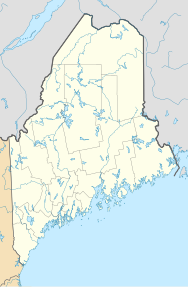Dixmont, Maine
| Dixmont, Maine | |
|---|---|
| Town | |
| Motto: "The Best Town in Maine!" | |
| Location within the state of Maine | |
| Coordinates: 44°41′23″N 69°7′29″W / 44.68972°N 69.12472°WCoordinates: 44°41′23″N 69°7′29″W / 44.68972°N 69.12472°W | |
| Country | United States |
| State | Maine |
| County | Penobscot |
| Area | |
| • Total | 36.43 sq mi (94.35 km2) |
| • Land | 36.29 sq mi (93.99 km2) |
| • Water | 0.14 sq mi (0.36 km2) |
| Elevation | 518 ft (158 m) |
| Population (2010) | |
| • Total | 1,181 |
| • Estimate (2012) | 1,173 |
| • Density | 32.5/sq mi (12.5/km2) |
| Time zone | Eastern (EST) (UTC-5) |
| • Summer (DST) | EDT (UTC-4) |
| ZIP code | 04932 |
| Area code(s) | 207 |
| FIPS code | 23-17950 |
| GNIS feature ID | 0582444 |
| Website | www |
Dixmont is a town in Penobscot County, Maine, United States. The population was 1,181 at the 2010 census. It is part of the Bangor Metropolitan Statistical Area.
Dixmont was originally granted by the Commonwealth of Massachusetts (of which Maine was then a part) to Bowdoin College, which sold the first settlers their land. For that reason it was initially called "Collegetown". The first settlement was made in 1799.
One of the largest purchasers of land in Collegetown was Dr. Elijah Dix of Boston, who never lived there but took an interest in its settlement. When the town was incorporated in 1807, it named itself after Dix. A "malignant fever" broke out among the settlers that same year, killing many of them. Still, the population grew in the decade 1800-1810 from 59 to 337, a rate of increase never repeated. Dr. Dix also died in Dixmont on a trip there in 1809, and was buried in the Dixmont Corner Cemetery.
Dix was the grandfather of reformer Dorothea Dix, who was born in nearby Hampden. Her father was probably the family's land agent, overseeing settlement in Dixmont. Dixfield, Maine, in Oxford County, is also named after Dr. Dix.
Dixmont was on the main stage-coach route between Bangor and Augusta, and given that it had the highest elevation along that road, it became a natural rest-stop for tired horses. Wrote William Lloyd Garrison in 1832: "The Dixmont Hills are famous and formidable along this route . . . they are piled upon my memory in all their massive mobility."
By the 1850s the population of the town had peaked at over 1,600, which is over 400 more than it has today. It had three sawmills, a shingle mill, two flour and grist mills, and many productive farms.
...
Wikipedia

